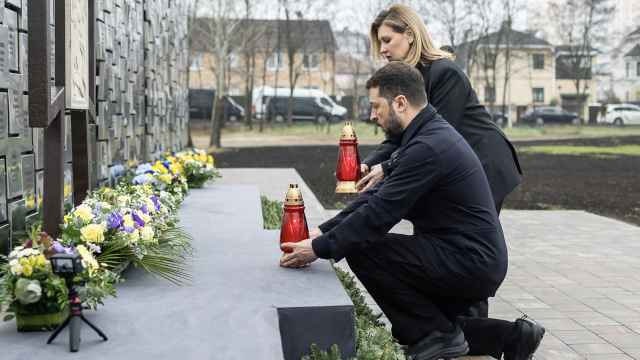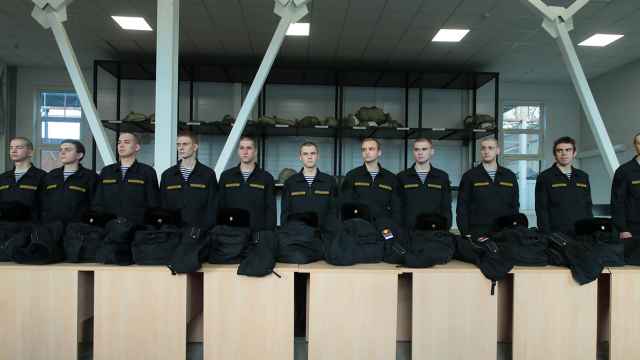Editor's Note: This is the first of five articles about President Medvedev's efforts to modernize the economy.
Most of the customers at a drug store in northern Moscow prefer medicines made abroad because of their better reputation for quality.
"At this point, people don't trust Russian drug makers," said Larisa Bezuglaya, a pharmacist at the drug store.
Svetlana Kopteva, 34, who had just bought a bottle of French moisturizing cream, agreed, saying it didn't matter that Russian-made drugs were cheaper.
"If Russian drug makers improved the quality of their products while retaining lower prices than foreign firms, I might change my mind," she said.
The Russian government is hoping she will.
As of 2007, only one out of every five drugs purchased in Russia was produced domestically, and only one of the top 20 producers of drugs sold domestically was a Russian firm — Pharmstandart.
This dependence on imports, and the backward state of the industry, have led President Dmitry Medvedev to declare the modernization of the pharmaceutical industry a national priority and one of the five key priority areas for modernization.
The market is not without prospects: Since 2003, the Russian market has grown on average 10 percent to 12 percent annually. But it still accounts for less than 2 percent of the global market. Most troubling, Russia only accounts for a paltry 0.3 percent of the world's drug production.
One reason for this state of affairs is the old equipment and ancient facilities that form the backbone of the industry, said Deputy Industry and Trade Minister Denis Manturov.
"There's a lag in the technological development of facilities needed to manufacture competitive products in accordance with international standards," Manturov said in an e-mailed statement.
Another problem is that most pharmaceutical production in Russia is currently geared toward the production of generic medicines, with very little spent on research and development of innovative drugs, said Manturov, who is a member of the pharmaceutical working group of the presidential commission for modernization.
Most Russian drug makers produce low-profit generic drugs, which allows companies to appropriate just 1 to 2 percent of their revenues for research and development, compared to 5 to 10 percent spent by U.S. and European drug makers, whose portfolios consist mostly of innovative compounds.
Investment Needed
Dragging the country's aging medical technology into the 21st century and increasing the amount of research and development that is done on Russian soil is going to take a lot of investment — both on the part of the government and foreign pharmaceutical firms.
The government's strategy for tackling this problem is the Pharma 2020 strategy, which aims to raise the competitiveness of the industry, stimulate the production of innovative medicines, modernize factories' equipment, remove administrative barriers for drug registration and launch educational programs.
The goal is an ambitious one: to raise the share of domestically produced medicines from the current 23 percent to 50 percent over the coming 10 years.
Doing so will reduce the country's dependence on imports, as well as make medicines more affordable for consumers and the government, Manturov said.
"There is no doubt that a significant increase in the share of domestically produced medicines on the market will result in decreased prices for the final products. Thus, as a result of import substitution, the anticipated budget savings in state purchases will account for 20 to 30 percent," he said.
The strategy calls for 178 billion rubles ($5.84 billion) of investment in the pharmaceutical sector over the next decade in three key areas: research and development, training and infrastructure development, and introducing good manufacturing practices at all Russian facilities.
Much of that investment figure will be state funds, funneled through either regular budget allocations or one of the federal target programs — state funding vehicles created to accomplish certain development goals.
Industry and Trade Minister Viktor Khristenko said last month that the government was ready to appropriate as much as 120 billion rubles of state funds for supporting the pharmaceutical industry.
The government is also doing the best it can to entice international pharmaceutical companies to invest in Russia.
Setting Up Shop
International drug makers are betting that despite the obstacles, they will be able to succeed on the Russian market. A group of pharmaceutical firms have pledged to invest up to 1 billion euros ($1.3 billion) in their localization projects over the next several years, and many have already embarked on that process.
"We have proved over the past year that this was not an empty declaration. … It's an absolutely concrete statement, which is supported by concrete investments. … And I think it's only a start," said Vladimir Shipkov, executive director of the Association of International Pharmaceutical Manufacturers.
In April, Novo Nordisk, the world's largest producer of diabetes drugs, agreed to invest as much as $80 million to $100 million in the construction of an insulin-packaging plant in the Kaluga region, the Danish firm said in a statement.
Initially the plant will pack insulin in cartridges and insulin-delivering devices, but it may expand later to full-scale insulin production.
In June, Swiss company Nycomed began construction on a plant in the Yaroslavl region in which it will invest up to 75 million euros ($97 million).
The factory will take over the production of several of its portfolio drugs intended for the Russian market and will make up to 3 billion tablets and 180 million ampoules per year, said Jostein Davidsen, managing director of Nycomed in Russia and the Commonwealth of Independent States.
"The plant will contribute to better product availability in the Russian market, higher service level, logistics excellence. In fact, this is in line … with the 2020 strategy of the Russian government to focus more on local manufacturing," Davidsen said.
Nycomed has also agreed to team up with General Electric's health care unit to establish a joint venture producing contrast agents for X-rays and MRI equipment.
"Production of contrast agents is a small niche. This market is not that big in Russia. It's a market of not more than 50 million euros today," Davidsen said in an interview, adding that the manufacturing of these medicines was "a priority segment," which was expected to show "significant growth" in Russia.
Government's Duties
But while drug makers have been cautiously dipping their toes into the water, before diving in they want to see a concerted effort on the part of the government to invest in the health care industry and put spending in the sector on par with that of the developed world.
It would be much easier to attract investment if the amount invested by the government into the health care system were comparable to that in developed countries, said Naira Adamyan, the Russian head of Janssen-Cilag, a subsidiary of Johnson & Johnson.
Russia spends only about 3 percent of its gross domestic product on health care, compared with 8 percent to 10 percent in most European countries.
"It's clear that with the huge amount of problems we have in the health care field [this level of spending] is absolutely insufficient," Adamyan said. "It's very hard to speak of very massive … investments in a country where only a few percent of the population are reimbursed with medicines on preferential terms."
Davidsen agreed, saying that while the government has done a lot of work to boost the health care industry in recent years, there is still much to be done.
"There's still a lot of spending that should be going toward health care before it becomes a relatively defendable marketplace for future significant investments," he said.
Innovation
Building new factories with new machinery is a crucial aspect of the modernization agenda. But the government is hoping that these plants won't just be producing drugs developed somewhere else.
That's why it's funneling hundreds of billions of dollars into human capital programs, as well as research and development, in order to make Russia a center for the development of innovative medicines.
And there are already signs that progress has been made toward achieving this goal.
Under the agreement signed in September, Swiss health care giant Roche has supplied Russian research center Chemrar with AIDS trial drugs at the pre-clinical development stage. The drugs will undergo further development in Russia and Chemrar will retain the right to sell the future medicines in Russia and the CIS.
Earlier this month, state investment fund Rusnano said it would back a $160 million project with Chemrar to develop innovative medicines for cancer and hepatitis C.
The Chemrar center is among the 11 pharmaceutical modernization projects getting support from the presidential commission on modernization because it will be manufacturing products with a potential for export, said Alexander Ivashchenko, Chemrar's chairman.
Other projects range from medical equipment facilities to factories producing nuclear tracers.
Legislative Limits
But to develop an innovative and vibrant pharmaceutical industry, more is needed than infusions of cash. A legislative and regulatory environment conducive to growth is another necessary step.
The State Duma tried to take a step toward that end in March, when it approved a hotly contested law on the circulation of medicines, which outlines a new drug registration process, requires producers to transition to good manufacturing practices, tightens sanctions on counterfeit drugs and imposes retail prices controls.
The new law, which replaced the old Medicines Law passed more than 10 years ago, significantly cuts some red tape for manufacturers by requiring regulators to register new drugs within 210 days for both Russian and foreign drug makers. Previously, the procedure took up to a year and a half or more.
But the new legislation is not likely to allay manufacturers' concerns about intellectual property rights.
"While the old legislation defined an original medicine as one that was under patent protection, the new legislation defines it as medicine containing a new active pharmaceutical ingredient," said Yulia Fyodorova, senior lawyer at international law firm CMS.
"That means that according to the new law, a generic drug may be theoretically acknowledged as an original medicine if it appears on the Russian market before the original medical product is registered in Russia," she said.
But perhaps more serious is the lack of data protection in the new law, making foreign drug makers reluctant to register new medicines in Russia.
When registering a new medicine, producers have to provide regulators with all the data generated in pre-clinical and clinical testing in order to prove that the medicine is safe.
"The secret information that is protected by data protection regimes in the West is not protected in Russia. As a result producers can register their generic drugs using, for example, clinical trials data of the original medicine, which causes producers of original medicines to bear losses," Fyodorova told The Moscow Times.
Prognosis
Despite the pitfalls, drug makers are optimistic about the future of the Russian pharmaceutical market. Russia's pharmaceutical market may see compounded annual growth of 15 percent to 16 percent through 2015, said Patrick Aghanian, the Russia head of Sanofi-Aventis, Europe's biggest drug maker.
"Eight years ago, the volume of the pharmaceutical market in Russia accounted for maybe $3 billion. Last year, it was more than $14 billion," he said, adding that this growth was a good driver for raising additional investments.
But Russia isn't alone in the race to develop an innovative pharmaceutical industry.
Russia lags behind its BRIC peers in the size of its market and the competitiveness of its industry. In 2009, when the worldwide recession caused Russia's pharmaceutical market to shrink 5 percent, China's grew 27 percent and Brazil's shot up 14 percent.
Compared with dynamic markets such as these, Russia needs to be able to offer global players a good reason to bet on it, rather than on other developing countries.
Russia's low level of competitiveness compared with its developing country peers is one of its main problems, Aghanian said.
"We need to talk about how we can make the Russian market even more attractive, say, as attractive as the Chinese market," he said.
A Message from The Moscow Times:
Dear readers,
We are facing unprecedented challenges. Russia's Prosecutor General's Office has designated The Moscow Times as an "undesirable" organization, criminalizing our work and putting our staff at risk of prosecution. This follows our earlier unjust labeling as a "foreign agent."
These actions are direct attempts to silence independent journalism in Russia. The authorities claim our work "discredits the decisions of the Russian leadership." We see things differently: we strive to provide accurate, unbiased reporting on Russia.
We, the journalists of The Moscow Times, refuse to be silenced. But to continue our work, we need your help.
Your support, no matter how small, makes a world of difference. If you can, please support us monthly starting from just $2. It's quick to set up, and every contribution makes a significant impact.
By supporting The Moscow Times, you're defending open, independent journalism in the face of repression. Thank you for standing with us.
Remind me later.





